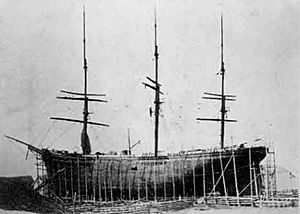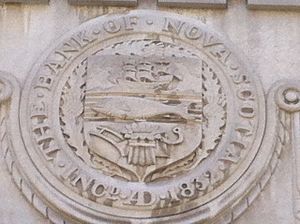William D. Lawrence (ship) facts for kids
 |
|
Quick facts for kids History |
|
|---|---|
| Name | William D. Lawrence |
| Owner | William Dawson Lawrence and James Ellis |
| Port of registry | Maitland, Nova Scotia |
| Builder | William D. Lawrence Shipyard, Maitland Nova Scotia |
| Laid down | 1872 |
| Launched | October 27, 1874 |
| Maiden voyage | 1874-1875 |
| Identification | |
| Fate | Stranded English Channel, 1891, converted to barge, sunk in Dakar. |
| Notes | Renamed Kommander Svend Foyn, 1883 |
| General characteristics | |
| Tonnage | 2459 Gross Tons |
| Length |
|
| Beam | 48 ft (15 m) |
| Depth | 29 ft (8.8 m) |
| Decks | 2 |
| Propulsion | Sail |
| Sail plan | Full-rigged ship |
The William D. Lawrence was a huge full-rigged sailing ship built in Maitland, Nova Scotia. It was named after its builder, William Dawson Lawrence, who was a businessman and a politician. This ship was a special type called a full-rigged ship, meaning it had tall masts and many sails.
Contents
Building the Giant Ship
The William D. Lawrence was built in 1874 at the William D. Lawrence Shipyard in Maitland. It was the biggest wooden sailing ship of its time. In fact, it was one of the largest wooden ships ever built anywhere. It was also the largest sailing ship ever built in Canada.
Why So Big?
William Lawrence, the builder, was against Canadian Confederation. This was when different Canadian colonies joined together to form one country. He believed it would harm Nova Scotia's busy shipbuilding business. He had planned to build a smaller ship. But he decided to make the William D. Lawrence extra large. He wanted it to be a symbol for Nova Scotia's shipbuilding before the industry might slow down. Many people thought such a big wooden ship would be too hard to control and would lose money. But the ship proved them wrong!
The Ship's Journeys and End
After several years of successful voyages, the ship was sold in 1883. Its new owners were from Norway, and they renamed it Kommandør Svend Foyn. In 1891, the ship got stuck in the English Channel. It was then turned into a barge, which is a flat-bottomed boat used for carrying goods. Later, it sank in Dakar, Africa.
Remembering the William D. Lawrence
The William D. Lawrence and its builder, William D. Lawrence, have been remembered in many ways.

Special Tributes
- In 1930, the Bank of Nova Scotia placed a stone carving of the ship above the door of its main office in Halifax, Nova Scotia.
- A monument was put up in 1967 at William Lawrence's home. It honored his ship as a national historic treasure.
- His home became a public museum in 1971.
- Canada Post released a postage stamp featuring the ship in 1975.
- The Royal Canadian Mint made a coin with the ship's image in 2002.
Art and Local Celebrations
At least three official paintings were made of the ship. One is at the Nova Scotia Museum, another at the Nova Scotia Archives and Records Management, and a third by Edouard-Marie Adam is in Paris, France.
The ship's amazing story is also celebrated in Maitland. There's a National Historic Site monument at Lawrence House, which is part of the Nova Scotia Museum. Every September, Maitland holds a festival called "Launch Days." This festival celebrates the day the William D. Lawrence was first launched into the water.

